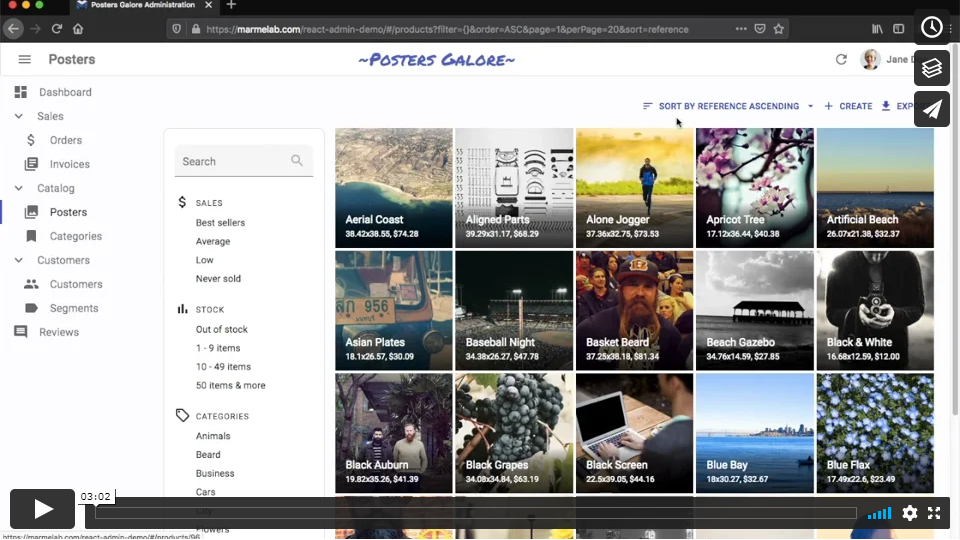@mochilabs/ra-data-simple-rest v3.17.2
Simple REST Data Provider For React-Admin
Simple REST Data Provider for react-admin, the frontend framework for building admin applications on top of REST/GraphQL services.
Installation
npm install --save ra-data-simple-restREST Dialect
This Data Provider fits REST APIs using simple GET parameters for filters and sorting. This is the dialect used for instance in FakeRest.
| Method | API calls |
|---|---|
getList | GET http://my.api.url/posts?sort=["title","ASC"]&range=[0, 24]&filter={"title":"bar"} |
getOne | GET http://my.api.url/posts/123 |
getMany | GET http://my.api.url/posts?filter={"id":[123,456,789]} |
getManyReference | GET http://my.api.url/posts?filter={"author_id":345} |
create | POST http://my.api.url/posts |
update | PUT http://my.api.url/posts/123 |
updateMany | Multiple calls to PUT http://my.api.url/posts/123 |
delete | DELETE http://my.api.url/posts/123 |
deleteMany | Multiple calls to DELETE http://my.api.url/posts/123 |
The API response when called by getList should look like this:
[
{ "id": 0, "author_id": 0, "title": "Anna Karenina" },
{ "id": 1, "author_id": 0, "title": "War and Peace" },
{ "id": 2, "author_id": 1, "title": "Pride and Prejudice" },
{ "id": 2, "author_id": 1, "title": "Pride and Prejudice" },
{ "id": 3, "author_id": 1, "title": "Sense and Sensibility" }
]An id field is required. You can also set custom identifier or primary key for your resources
Note: The simple REST data provider expects the API to include a Content-Range header in the response to getList calls. The value must be the total number of resources in the collection. This allows react-admin to know how many pages of resources there are in total, and build the pagination controls.
Content-Range: posts 0-24/319If your API is on another domain as the JS code, you'll need to whitelist this header with an Access-Control-Expose-Headers CORS header.
Access-Control-Expose-Headers: Content-RangeUsage
// in src/App.js
import * as React from "react";
import { Admin, Resource } from 'react-admin';
import simpleRestProvider from '@mochilabs/ra-data-simple-rest';
import { PostList } from './posts';
const App = () => (
<Admin dataProvider={simpleRestProvider('http://path.to.my.api/')}>
<Resource name="posts" list={PostList} />
</Admin>
);
export default App;Adding Custom Headers
The provider function accepts an HTTP client function as second argument. By default, they use react-admin's fetchUtils.fetchJson() as HTTP client. It's similar to HTML5 fetch(), except it handles JSON decoding and HTTP error codes automatically.
That means that if you need to add custom headers to your requests, you just need to wrap the fetchJson() call inside your own function:
import { fetchUtils, Admin, Resource } from 'react-admin';
import simpleRestProvider from '@mochilabs/ra-data-simple-rest';
const httpClient = (url, options = {}) => {
if (!options.headers) {
options.headers = new Headers({ Accept: 'application/json' });
}
// add your own headers here
options.headers.set('X-Custom-Header', 'foobar');
return fetchUtils.fetchJson(url, options);
};
const dataProvider = simpleRestProvider('http://localhost:3000', httpClient);
render(
<Admin dataProvider={dataProvider} title="Example Admin">
...
</Admin>,
document.getElementById('root')
);Now all the requests to the REST API will contain the X-Custom-Header: foobar header.
Tip: The most common usage of custom headers is for authentication. fetchJson has built-on support for the Authorization token header:
const httpClient = (url, options = {}) => {
options.user = {
authenticated: true,
token: 'SRTRDFVESGNJYTUKTYTHRG'
};
return fetchUtils.fetchJson(url, options);
};Now all the requests to the REST API will contain the Authorization: SRTRDFVESGNJYTUKTYTHRG header.
Note about Content-Range
Historically, Simple REST Data Provider uses the http Content-Range header to retrieve the number of items in a collection. But this is a hack of the primary role of this header.
However this can be problematic, for example within an infrastructure using a Varnish that may use, modify or delete this header. We also have feedback indicating that using this header is problematic when you host your application on Vercel.
The solution is to use another http header to return the number of collection's items. The other header commonly used for this is X-Total-Count. So if you use X-Total-Count, you will have to :
- Whitelist this header with an
Access-Control-Expose-HeadersCORS header.
Access-Control-Expose-Headers: X-Total-Count- Use the third parameter of
simpleRestProviderto specify the name of the header to use :
// in src/App.js
import * as React from "react";
import { Admin, Resource } from 'react-admin';
import { fetchUtils } from '@mochilabs/ra-core';
import simpleRestProvider from '@mochilabs/ra-data-simple-rest';
import { PostList } from './posts';
const App = () => (
<Admin dataProvider={simpleRestProvider('http://path.to.my.api/', fetchUtils.fetchJson, 'X-Total-Count')}>
<Resource name="posts" list={PostList} />
</Admin>
);
export default App;License
This data provider is licensed under the MIT License, and sponsored by marmelab.
